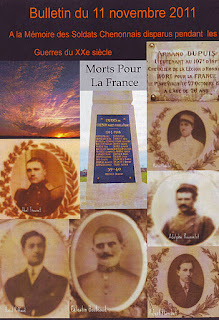Bois Eugene, Mort pour la France: 10.03.1917 à Verdun.
Eugène Bois born in Bayers, a village to the South of Chenon, died in March 1917 and is buried in the family grave in Chenon. He was the
only son of Marie Sauvage and her husband François Bois. He enlisted in his Regiment in 1913, aged 20 years and was serving with his
regiment in the second battle of Verdun in the North West Sector near Beaumont.
He was severely wounded and later died at the hospital at Vadelaincourt. He was
the recipient of the Croix de Guerre Militaire, the cross for military valour. This would have been awarded as a result of one or more citations
for valour – the equivalent of being mentioned in dispatches.
Vadelaincourt
(in the department of the Meuse) during the First World War – A very busy evacuation
hospital No. 12, to the South of Verdun. It was placed there as it was sheltered from enemy
canon fire and had the advantage of road and railway links. It also had the use of various houses, outbuildings and lofts of the abandoned
Château Génin. The admissions office was
in the first house coming from the direction of Verdun, the pharmacy was
opposite the town hall and the hospital management used the Château. The
cemetery near to the village was
used for the burial of those killed on combat. Among these listed on the
slope which overlooked the route ‘des Souhemmes’ one must not forget the number
and names of the stretcher bearers, nurses and other carers who looked after
the combatants.
Extract from the journal of a nurse who worked
at the hospital in the early summer of 1917 - May Guinness
“Hospital
XII was the Verdun hospital which migrated when the battle and bombardment of
Verdun commenced, and finally settled beside the little river which gives its
name to the straggling village of Vadelaincourt, ten kilometres behind Verdun.
The château,
surrounded by large trees, was a good-sized house where the médecin-chef,
Monsieur Morin, lived and had his bureau, also several of the hospital officers
and some of the infirmières. (nurses) Beside the château were some picturesque farm
buildings reflected in a pond where soldiers watered their horses, and nearby,
under a horse chestnut tree, horses were shod at a military forge. Our ‘popote’
(mess) was in the quaint white-washed kitchen of a cottage. The infirmières sat
in their white dresses and veils. The oriflamme banner brought with them from
Verdun hung against the end wall, and above the door was a black crucifix, and
on the overhanging mantelboard a blue china Madonna. The infirmière-major and
three others lived in this cottage. It was infested with rats which kept them
awake at nights, scampering about the floor of their bedrooms.”
On the nights of 20th and 21st August 1917, despite being
clearly marked with Geneva Convention crosses this hospital together with three
others in the region were bombed by enemy aircraft. There were many casualties both patients ans staff. The hospital was subsequently abandoned.
The full account is available at the following link:
http://thedublinreview.com/article/the-bombardment-of-vadelaincourt
 |
The Oriflamme banner of St. Denis revered by the Kings of France in the middle
ages.
|




Commentaires